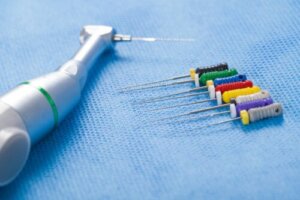Endodontic Treatments in Children: When Is It Advisable?

Endodontic treatments are a dental practice that seeks to rehabilitate the innermost area of the teeth, where the dental pulp is, in order to preserve the external structure in the mouth.
Some parents are hesitant about the need to access this treatment for their children, especially when the pediatric dentist suggests performing it on baby teeth that will later fall out. Others fear that it’s the same procedure performed on adults.
That’s why today we’re going to tell you about the importance of performing this treatment on children and when it’s necessary. Read on and find out all about endodontics in children.
What does endodontics in children consist of?
As we’ve already mentioned, endodontics are treatments that are performed in the innermost area of the dental elements, where the dental pulp is located. The objective is to keep the teeth in the mouth but to resolve the disease in progress.
The techniques for performing a root canal in children vary according to the conditions and needs of the case. Therefore, the dentist should consider several factors before proceeding, such as the following:
- Affected dentition: whether it’s a primary or permanent tooth
- Degree of root formation of the permanent teeth
- Length of time the baby tooth remains in the mouth: how long before the tooth falls out naturally
- Type of injury and severity
- Extent of damage: whether it affects only the tooth or has spread to the bone and gums
- Health problems or systemic diseases of the child
- Cooperation of the child in the dental consultation
Depending on these aspects, different alternatives can be chosen to treat the damaged teeth.

Endodontic options in children
Endodontic treatments in children aren’t the classic root canal treatment performed in adults. There are several alternatives to solve each case in the best possible way. Below, we’ll tell you about the different options available.
Pulp protection
It’s not a root canal itself but is a treatment that’s performed on the pulp. It consists of protecting the tissue when it’s been exposed accidentally or by trauma, but without there being considerable damage.
Different pastes and medications are used that are placed in depth before the fillings are placed.
Pulpotomy
This is performed on teeth with vital but damaged pulp and requires the use of anesthesia.
The superficial tissue is removed, but the tissue in the canals, that is, in the root zone, is preserved. Once the canal area is cleaned, it’s filled with protective materials and then restored with fillings or crowns.
This is done in both baby teeth and permanent teeth whose roots haven’t finished forming. In these cases, when apex closure is complete, conventional adult endodontics will be necessary.
Pulpectomy
This consists of removing all the pulp tissue from the baby teeth, cleaning the area, and filling it with special pastes.
The material seals the area, prevents the proliferation of germs, and, at the same time, can be reabsorbed by the definitive tooth when the baby tooth falls out. Therefore, the treated tooth can fall out at the time of tooth replacement.
Apicoformation
This is an endodontic procedure performed on young permanent teeth, which haven’t yet completed the formation of their roots.
Special materials are placed on a regular basis to promote the closure of the apices and ensure proper tooth development. When this is achieved, we proceed with conventional endodontics with definitive materials.
Conventional endodontics
These are the same procedures that are carried out in adults, as they’re performed in the definitive dental pieces and with the entire root formed.
They consist of removing and cleaning the pulp of the crown and root and filling with definitive materials.
When are root canals recommended for children?
Root canals in children are used to treat badly damaged teeth. And as we’ve told you, there’s a wide range of possible techniques to put into practice.
This makes it possible to treat different situations and restore harmony to the oral cavity, both in the disease of baby teeth and permanent teeth.
Endodontic treatments in children are indicated to resolve inflammation and pain, necrosis, and dental infections. Most of the time, these conditions arise as a consequence of very severe and advanced cavities that have destroyed the tooth in depth.
Another very common reason for pulp damage is dental trauma, as intense blows can damage the innermost area of the teeth and root canals are the treatment to restore health.
Symptoms that indicate the need for endodontic treatments in children
As we told you before, inflammation of the pulp, necrosis or pulp death, and dental infections are the reasons that lead dentists to choose this type of therapy.
You can suspect that your child suffers from these problems if they have some of the following symptoms:
- Broken, fractured teeth or teeth with large cavities
- Pain in the tooth or radiating to the jaw
- Sensitivity to cold, heat, sweets, or biting
- A fistula or pimple from which pus comes out through the gum or in the vicinity of the tooth
- Inflamed or swollen gums
- Edema or swelling in the face or neck

The importance of preserving teeth in the mouth
It’s common for some parents to wonder if it’s really necessary to perform these interventions on baby teeth, which will eventually fall out. If in a few years, they’re going to fall out, then why worry about them? It’s important to clarify that unless the tooth is about to erupt on its own, the best option is to keep the teeth in the mouth. Both baby teeth and definitive teeth.
Having all the teeth in the oral cavity allows children to carry out important oral functions, such as eating, speaking, and smiling normally. Even avoiding certain insecurity complexes or problems of low self-esteem due to the absence of teeth in their mouths. In addition, in the case of baby teeth, their presence favors the correct development of the jaws and they serve as guides for the eruption of the definitive teeth. This prevents malocclusions and dental malpositions in the future.
Therefore, if your pediatric dentist suggests that endodontics is the best alternative to restore your child’s oral health, don’t hesitate to proceed with this solution. This way, your little one will keep their teeth in their mouth and will be able to smile with peace of mind whenever they want to.
Endodontic treatments are a dental practice that seeks to rehabilitate the innermost area of the teeth, where the dental pulp is, in order to preserve the external structure in the mouth.
Some parents are hesitant about the need to access this treatment for their children, especially when the pediatric dentist suggests performing it on baby teeth that will later fall out. Others fear that it’s the same procedure performed on adults.
That’s why today we’re going to tell you about the importance of performing this treatment on children and when it’s necessary. Read on and find out all about endodontics in children.
What does endodontics in children consist of?
As we’ve already mentioned, endodontics are treatments that are performed in the innermost area of the dental elements, where the dental pulp is located. The objective is to keep the teeth in the mouth but to resolve the disease in progress.
The techniques for performing a root canal in children vary according to the conditions and needs of the case. Therefore, the dentist should consider several factors before proceeding, such as the following:
- Affected dentition: whether it’s a primary or permanent tooth
- Degree of root formation of the permanent teeth
- Length of time the baby tooth remains in the mouth: how long before the tooth falls out naturally
- Type of injury and severity
- Extent of damage: whether it affects only the tooth or has spread to the bone and gums
- Health problems or systemic diseases of the child
- Cooperation of the child in the dental consultation
Depending on these aspects, different alternatives can be chosen to treat the damaged teeth.

Endodontic options in children
Endodontic treatments in children aren’t the classic root canal treatment performed in adults. There are several alternatives to solve each case in the best possible way. Below, we’ll tell you about the different options available.
Pulp protection
It’s not a root canal itself but is a treatment that’s performed on the pulp. It consists of protecting the tissue when it’s been exposed accidentally or by trauma, but without there being considerable damage.
Different pastes and medications are used that are placed in depth before the fillings are placed.
Pulpotomy
This is performed on teeth with vital but damaged pulp and requires the use of anesthesia.
The superficial tissue is removed, but the tissue in the canals, that is, in the root zone, is preserved. Once the canal area is cleaned, it’s filled with protective materials and then restored with fillings or crowns.
This is done in both baby teeth and permanent teeth whose roots haven’t finished forming. In these cases, when apex closure is complete, conventional adult endodontics will be necessary.
Pulpectomy
This consists of removing all the pulp tissue from the baby teeth, cleaning the area, and filling it with special pastes.
The material seals the area, prevents the proliferation of germs, and, at the same time, can be reabsorbed by the definitive tooth when the baby tooth falls out. Therefore, the treated tooth can fall out at the time of tooth replacement.
Apicoformation
This is an endodontic procedure performed on young permanent teeth, which haven’t yet completed the formation of their roots.
Special materials are placed on a regular basis to promote the closure of the apices and ensure proper tooth development. When this is achieved, we proceed with conventional endodontics with definitive materials.
Conventional endodontics
These are the same procedures that are carried out in adults, as they’re performed in the definitive dental pieces and with the entire root formed.
They consist of removing and cleaning the pulp of the crown and root and filling with definitive materials.
When are root canals recommended for children?
Root canals in children are used to treat badly damaged teeth. And as we’ve told you, there’s a wide range of possible techniques to put into practice.
This makes it possible to treat different situations and restore harmony to the oral cavity, both in the disease of baby teeth and permanent teeth.
Endodontic treatments in children are indicated to resolve inflammation and pain, necrosis, and dental infections. Most of the time, these conditions arise as a consequence of very severe and advanced cavities that have destroyed the tooth in depth.
Another very common reason for pulp damage is dental trauma, as intense blows can damage the innermost area of the teeth and root canals are the treatment to restore health.
Symptoms that indicate the need for endodontic treatments in children
As we told you before, inflammation of the pulp, necrosis or pulp death, and dental infections are the reasons that lead dentists to choose this type of therapy.
You can suspect that your child suffers from these problems if they have some of the following symptoms:
- Broken, fractured teeth or teeth with large cavities
- Pain in the tooth or radiating to the jaw
- Sensitivity to cold, heat, sweets, or biting
- A fistula or pimple from which pus comes out through the gum or in the vicinity of the tooth
- Inflamed or swollen gums
- Edema or swelling in the face or neck

The importance of preserving teeth in the mouth
It’s common for some parents to wonder if it’s really necessary to perform these interventions on baby teeth, which will eventually fall out. If in a few years, they’re going to fall out, then why worry about them? It’s important to clarify that unless the tooth is about to erupt on its own, the best option is to keep the teeth in the mouth. Both baby teeth and definitive teeth.
Having all the teeth in the oral cavity allows children to carry out important oral functions, such as eating, speaking, and smiling normally. Even avoiding certain insecurity complexes or problems of low self-esteem due to the absence of teeth in their mouths. In addition, in the case of baby teeth, their presence favors the correct development of the jaws and they serve as guides for the eruption of the definitive teeth. This prevents malocclusions and dental malpositions in the future.
Therefore, if your pediatric dentist suggests that endodontics is the best alternative to restore your child’s oral health, don’t hesitate to proceed with this solution. This way, your little one will keep their teeth in their mouth and will be able to smile with peace of mind whenever they want to.
All cited sources were thoroughly reviewed by our team to ensure their quality, reliability, currency, and validity. The bibliography of this article was considered reliable and of academic or scientific accuracy.
- Yoshpe, M., Kaufman, A. Y., Lin, S., & Ashkenazi, M. (2021). Regenerative endodontics: A promising tool to promote periapical healing and root maturation of necrotic immature permanent molars with apical periodontitis using platelet-rich fibrin (PRF). European Archives of Paediatric Dentistry, 22(3), 527-534.
- Thakkar, T. K., Naik, S., & Ghule, K. (2019). Advances in rotary endodontics in pediatric dentistry. EC Dent Sci, 18, 1320-30.
- Popoola, B. O., Ayebameru, O. E., & Olanloye, O. M. (2018). Endodontic treatment in children: a five-year retrospective study of cases seen at the University College Hospital, Ibadan, Nigeria. Annals of Ibadan postgraduate medicine, 16(2), 136-141.
- NT, P. C., González, R., & LA, V. B. (2021). Explorando otros paradigmas en endodoncia de dientes primarios. una revisión narrativa.
- Oliveira-del Rio, J. A., Mendoza-Castro, A. M., & Alvarado-Solórzano, A. M. (2017). Endodoncia en dientes temporales. Pulpotomía. Polo del Conocimiento, 2(6), 1288-1297.
- González Núñez, D., Trejo Quiroz, P., De León Torres, C., & Carmona Ruiz, D. (2010). Técnica de endodoncia no instrumentada mediante el uso de la pasta CTZ.
- Celi Viteri, J. V. (2012). Necropulpéctomia en dentición temporaria (Bachelor’s thesis, Universidad de Guayaquil. Facultad Piloto de Odontología).
- Llerena, H. C., & Hacking, A. D. (2014). Uso de barreras apicales y apexificación en endodoncia. Revista Estomatológica Herediana, 24(2), 120-120.
This text is provided for informational purposes only and does not replace consultation with a professional. If in doubt, consult your specialist.








